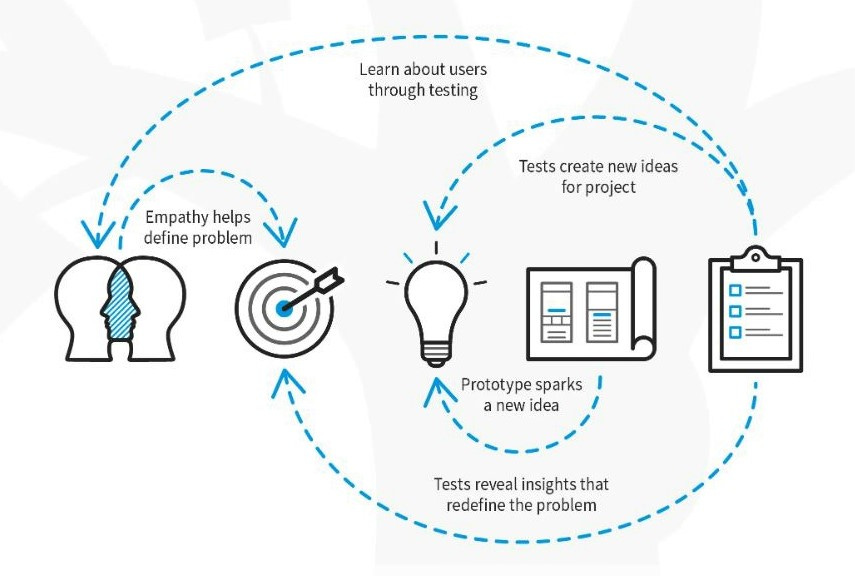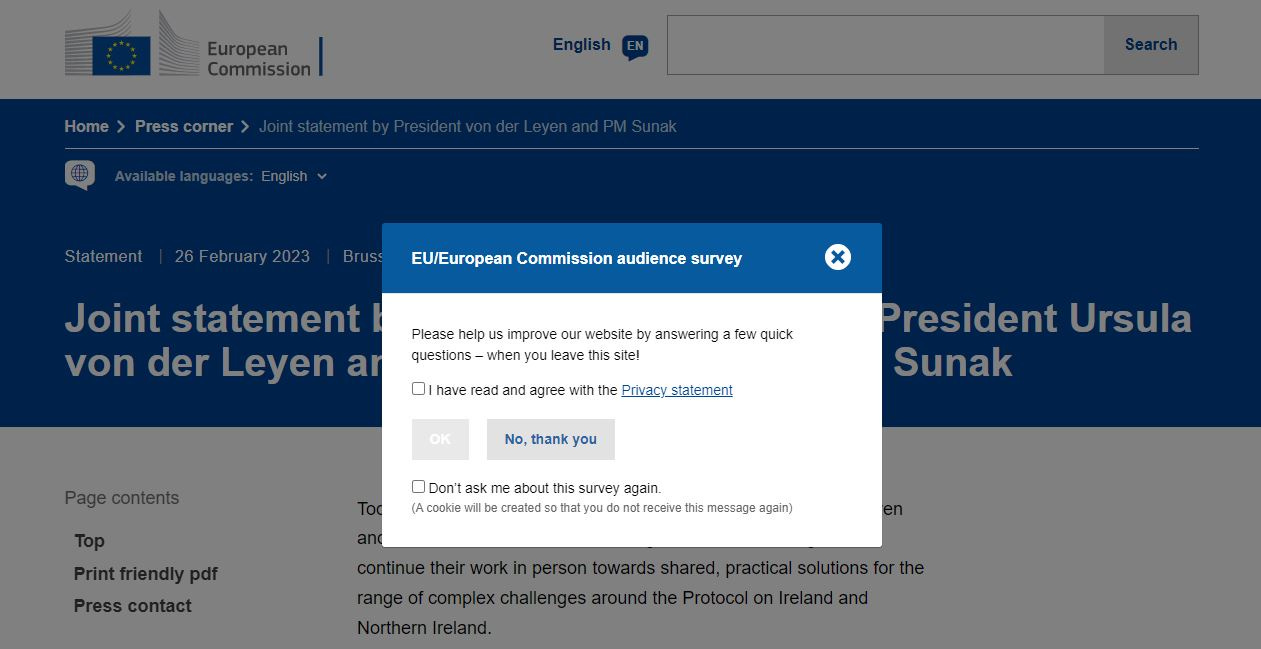This month I am delighted to share a guest piece by one of the most talented and thoughtful communicators I know - Ian McCafferty. Ian has worked in communication roles all over the European institutions and across many policy areas - including (but not limited to) agriculture, employment and social affairs, and migration.
What impresses me about they way he works is the deep research, thought and preparation that underpins his approach to communication - so we are very lucky to have him share an introduction to one of the methods he uses to improve organisational communication. I highly recommend getting in touch and/or following his work (on Twitter or LinkedIn).
Design thinking is a method used to make sure that the things you do provide actual solutions to actual problems.
While it’s mostly applied in the world of web and software development, design thinking can also be used to improve your communication strategy.
In this article, we’re going to explore design thinking principles and highlight a few practices that will help you better understand the real needs of your customer / client / user.
What is design thinking?
Design thinking is an innovative way of creating solutions to problems that people face. It employs a human-centred approach, meaning you solve these problems from the user’s perspective, often with their direct input.
While the terms used vary slightly, the main components of design thinking include:
Empathise: gather information about your users
Define: validate your assumptions with evidence
Ideate: generate new, innovative ideas to meet their needs
Prototype: develop draft versions of your ideas
Test: try out your solutions with actual users and learn from it
Design thinking encourages you to challenge your assumptions, (re)define the problems, and create effective solutions. It is an iterative, non-linear process, meaning you can repeat all of it, or parts of it, in whatever order you want.

Why use design thinking?
It doesn’t matter if you are a Silicon valley software designer or a Brussels bubble comms officer, if you can apply design thinking to what you do, the chances of your customer or client having a better user experience (UX) are so much higher.
And better experiences = positive perception = higher levels of trust.
Not only is it good for the user, design thinking can help you to clarify your vision and (re)develop your communication strategy by forcing you to answer the question favoured by three-year-olds around the world: why?


People tend to be better at doing than thinking. Especially when it comes to shiny new communication tools and trends, we have a tendency to do first and ask why later.
In my experience, people don’t always like to be asked why. Normally the only question that gets asked is ‘when?' (and the answer tends to be ASAP). But if you create products and services without considering real user needs you can end up with a report that nobody reads, a video that nobody watches, a metaverse party that nobody attends, etc.
The good news is, it’s not too late. Due to its non-linear nature, you can apply design thinking at any stage, whether you are starting a project or already well into your communication cycle.
I’m going to walk you through the first two steps - empathise and define. Even with just those you can unlock some really useful insights.
Empathise
Try to understand the thoughts, emotions and motivations of the people you are designing for.
Public opinion surveys offer excellent insight into people's preferences and points of view. In my experience the Eurobarometer is a good place to start.
For example, an EU food quality policy comms campaign I helped design - #InspiredbyGIs - drew upon a Eurobaromer survey which showed that, while most people cared about where their food came from and how it was produced, over 80% didn’t recognise the geographical indications labels that provided this information.





Voting patterns revealed in polling data can give you a sense of the interests and values of different demographics - particularly useful if you are targeting a certain country or region.
Europe Elects - Poll aggregation and election analysis in Europe
POLITICO Poll of Polls - European polls, trends and election news
European Values Study - insights into the ideas, beliefs, preferences, attitudes, values and opinions of citizens all over Europe
Conduct audience analyses by exploring your existing social media followers and website visitors with your social and web analytics tool of choice. What topics and content types resonate with them?
If you’re still not sure, ask them! Get useful audience input by using poll options on social platforms like Twitter or LinkedIn, or seek out user feedback directly on your website via random audience surveys.
With all this information you can start to make some astute assumptions about your target audience: their opinions, values, content and communication preferences.
But, as a prominent EU institution press team leader used to say, “assumption is the mother of all f**k ups”. So here’s how to turn these assumptions into real requirements.
Define
Test your assumptions against actual evidence to define real user needs.
A great way of structuring all the audience information you have gathered is in a user persona.
In Eurofound, we collected audience information from observation, analysis and in-house expertise to develop user personas - fictional representations of our core users - including:
Characterisation: what do they do and why?
Goals: what do they want to achieve?
Needs: what do they need to achieve their goals?
Pains: what’s preventing them from addressing their needs?
Communication: their preferred channels (and events).
However, in order to turn our assumptions into real user needs we had to do two things:
In 2022 we arranged qualitative stakeholder interviews with real people who represented these different personas to understand their perspectives and preferences.
We also launched a content performance survey to get feedback from our audience (segmented into primary, secondary and other) on how they used and valued Eurofound’s communication products and services, and what they would like to see more of.
All this information allowed us to validate the user persona descriptions and develop an in-depth understanding of each persona’s pains and gains at different stages of their user journey, from initial awareness to deeper engagement with our content.
Here’s how to do these things:
Qualitative stakeholder/’super user’ interviews:
Content performance surveys:
User persona and user journey mapping:

Another useful technique is the Top Tasks methodology.
This approach, championed by digital design guru Gerry McGovern, calls for the identification and continuous improvement of the things that matter most to your customers: so-called top tasks.
The European Commission used this approach to redesign its entire web presence in 2014. Having conducted extensive research on the main reasons for people using Commission websites, their digital transformation team established a list of 77 top tasks (from a MUCH larger long list) and launched an online poll for users to vote on what they believed to be the most important.
Following over 100,000 votes, 6 Top Tasks were identified and used to design an improved user experience on commission.europa.eu.
Design thinking can also be used to improve processes. You may think you know what the issues are, but one effective way of validating your assumption is to include those involved in a collaborative workshop.
When the European Commission wanted to improve the way it engaged local audiences online, it established a network of ‘digital leaders’ who would champion the use of social media and digital communication in Representation offices across the EU.
Rather than taking a top-down approach, we organised a collaborative workshop (World Cafe Method) to define the challenges and opportunities that the network faced, as well as to brainstorm ideas and start to generate solutions.
You can read more about that here.
Next steps
Once you have empathised with your user and defined their real needs, you have an excellent foundation to assess your current communication practices and/or develop new and improved products and services.
I hope this introduction to design thinking for communication helps. If you have any questions or any other ideas to add, I would love to hear from you (on Twitter or LinkedIn)!
If you want to dive deeper into the process…consult the internet! There are so many blogs, websites and courses (free and paid) ready to feed your brain. Here are a few things to consider:
The global design company, IDEO, is a pioneer of design thinking
Vitaly Friedman’s Smashing Magazine offers lots of great design insights
If you work in the Commission, search out the UX Office in DG DIGIT
And check out The agile comms handbook by Giles Turnbull
Thanks for reading,
Ian








A really impressive application of design thinking - kudos!!!